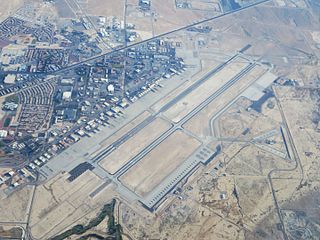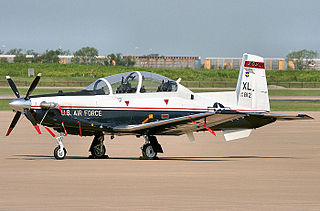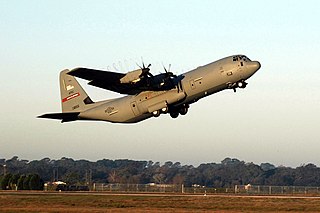
Williams Air Force Base is a former United States Air Force (USAF) base, located in Maricopa County, Arizona, east of Chandler, and about 30 miles (48 km) southeast of Phoenix. It is a designated Superfund site due to a number of soil and groundwater contaminants.

Nellis Air Force Base is a United States Air Force installation in southern Nevada. Nellis hosts air combat exercises such as Exercise Red Flag and close air support exercises such as Green Flag-West flown in "Military Operations Area (MOA) airspace", associated with the nearby Nevada Test and Training Range (NTTR). The base also has the Combined Air and Space Operations Center-Nellis.

Lackland Air Force Base is a United States Air Force (USAF) base located in Bexar County, Texas, United States. The base is under the jurisdiction of the 802d Mission Support Group, Air Education and Training Command (AETC) and an enclave of the city of San Antonio. It is the only site for USAF and United States Space Force enlisted Basic Military Training (BMT).

The Second Air Force is a USAF numbered air force responsible for conducting basic military and technical training for Air Force enlisted members and non-flying officers. In World War II the CONUS unit defended the Northwestern United States and Upper Great Plains regions and during the Cold War, was Strategic Air Command unit with strategic bombers and missiles. Elements of Second Air Force engaged in combat operations during the Korean War; Vietnam War, as well as Operation Desert Storm.

Laughlin Air Force Base is a facility of the United States Air Force located east of Del Rio, Texas.

Keesler Air Force Base is a United States Air Force base located in Biloxi, a city along the Gulf Coast in Harrison County, Mississippi, United States. The base is named in honor of aviator 2d Lt Samuel Reeves Keesler Jr., a Mississippi native killed in France during the First World War. The base is home of Headquarters, Second Air Force and the 81st Training Wing of the Air Education and Training Command (AETC).

Randolph Air Force Base is a United States Air Force base located at Universal City, Texas.

The Air Education and Training Command (AETC) is one of the nine Major Commands (MAJCOM) of the United States Air Force (USAF), reporting to Headquarters, United States Air Force. It was established 1 July 1993, with the realignment of Air Training Command and Air University.

Luke Air Force Base is a United States Air Force base in Maricopa County, Arizona, United States. It is located 7 miles west of the central business district of Glendale, and 15 miles west of Phoenix.

Goodfellow Air Force Base is a nonflying United States Air Force base located in San Angelo, Texas, United States. As part of Air Education and Training Command, Goodfellow's main mission is cryptologic and intelligence training for the Air Force, Space Force, Army, Coast Guard, Navy, and Marine Corps. Military firefighters are also trained here as part of the 312th Training Squadron. It is the home of the 17th Training Wing. The base is named for World War I aviator First Lieutenant John J. Goodfellow Jr.

Vance Air Force Base is a United States Air Force base located in southern Enid, Oklahoma, about 65 mi (105 km) north northwest of Oklahoma City. The base is named after local World War II hero and Medal of Honor recipient, Lieutenant Colonel Leon Robert Vance Jr.

The Air Training Command (ATC) is a former United States Air Force (USAF) Major Command designation. It was headquartered at Randolph Air Force Base, Texas, but was initially formed at Barksdale Air Force Base, Louisiana. It was re-designated as Air Education and Training Command (AETC) following a merger with Air University (AU) on 1 July 1993.

Foster Air Force Base is a former United States Air Force facility in Texas, located in Victoria County, approximately six miles (10 km) east-northeast of Victoria.

Donaldson Air Force Base is a former facility of the United States Air Force located south of Greenville, South Carolina. It was founded in 1942 as Greenville Army Air Base; it was deactivated in 1963 and converted into a civilian airport. It is currently an active airfield known as Donaldson Center Airport.

The 82nd Training Wing is a unit of the United States Air Force that is assigned to the Air Education and Training Command, Second Air Force. The training wing is stationed at Sheppard Air Force Base, Texas where it is also a host unit.

Graham Air Base was a United States Air Force base located in Marianna, Florida. After it was closed in 1960, it was reused as Marianna Municipal Airport.

Malden Regional Airport is a city-owned, public-use airport located three nautical miles (6 km) north of the central business district of Malden, a city in Dunklin County, Missouri, United States. This airport is included in the National Plan of Integrated Airport Systems, which categorized it as a general aviation facility.

Gulfport Combat Readiness Training Center is a United States Air Force training center, located at Gulfport-Biloxi International Airport, Mississippi. It is located 5 miles (8.0 km) north-northeast of Gulfport, Mississippi.

Webb Air Force Base, previously named Big Spring Air Force Base, was a United States Air Force facility of the Air Training Command that operated from 1951 to 1977 in West Texas within the current city limits of Big Spring. Webb AFB was a major undergraduate pilot training (UPT) facility for the Air Force, and by 1969, almost 9,000 pilots had been trained at Webb. The last operational wing at Webb AFB was the 78th Flying Training Wing.

Harlingen Air Force Base, originally Harlingen Army Airfield, is a former United States Air Force (USAF) base in northeast Harlingen, Texas. After the base closed, the field was redeveloped into Valley International Airport.


























